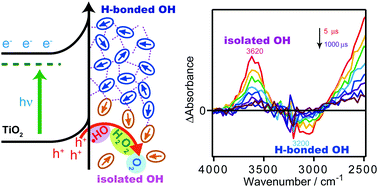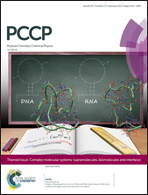Structural changes of water molecules during photoelectrochemical water oxidation on TiO2 thin film electrodes†
Abstract
Behaviors of photogenerated charge carriers and structural changes of water molecules on TiO2 photoelectrodes were investigated by using time-resolved visible to mid-IR absorption spectroscopy. From the spectra measured in the visible to NIR region, it was shown that the lifetime of trapped electrons and holes becomes longer upon applying more positive potentials. This result was reasonably explained by the enhancement of the upward band bending at the water/TiO2 interface. On the other hand, from the spectra measured in the mid-IR region, structural changes of the water molecules were observed. When a TiO2 electrode was photoexcited at the potential where the water oxidation starts, a new absorption peak appeared at 3620 cm−1 with a slight decrease in the intensity of hydrogen-bonded water. This new peak was assigned to the isolated O–H band of water molecules. Usually, TiO2 surfaces exhibit super-hydrophilic properties with strong hydrogen-bonding; however, the obtained result was opposite. Therefore, the appearance of this isolated O–H band was ascribed to the cleavage of the hydrogen-bonding networks resulting from the production of reaction intermediates such as OH radicals or H2O2. The intensity of the isolated O–H decreases when applying more positive potentials, where the O2 evolution proceeds more efficiently. This could be ascribed to the rapid consumption of the reaction intermediates. At these potentials, the intensity of hydrogen-bonded water was also further decreased.

- This article is part of the themed collection: Complex molecular systems: supramolecules, biomolecules and interfaces


 Please wait while we load your content...
Please wait while we load your content...